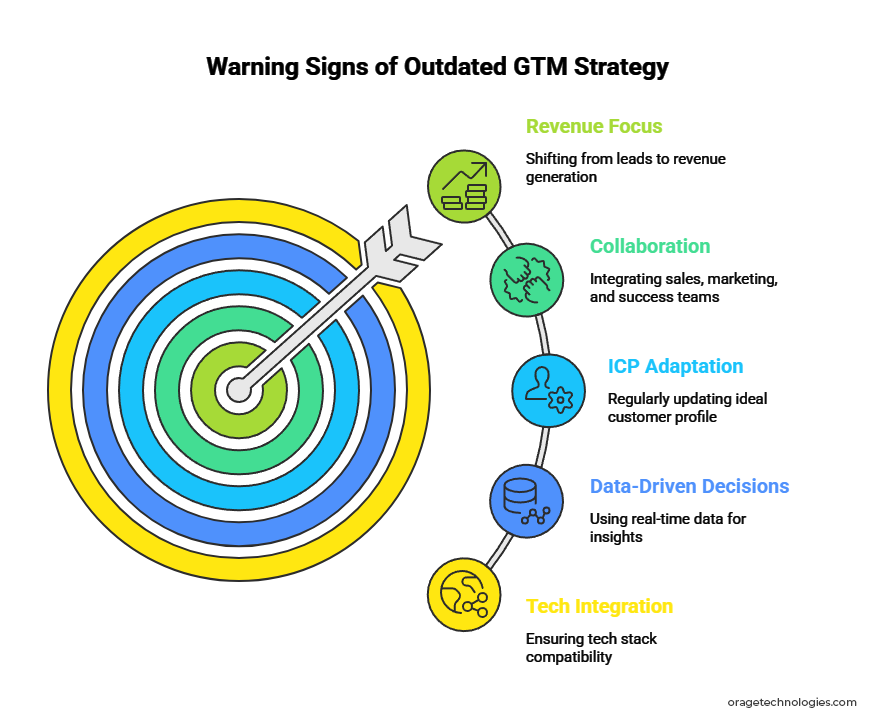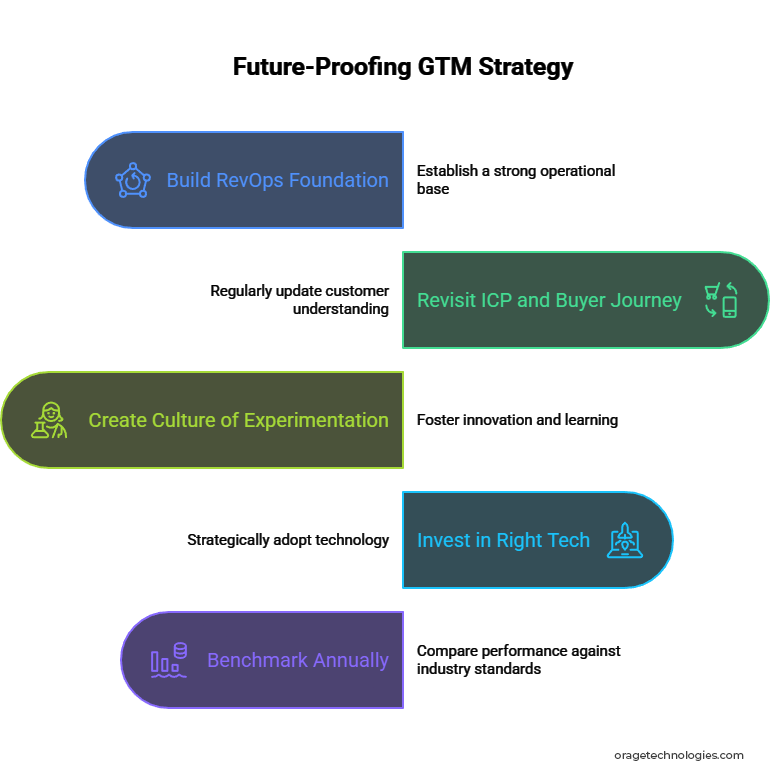
Divya Stuti, with over 5 years of experience in Digital Marketing & Content Writing, has a knack for turning complex Marketing strategies, trends, and jargon...
Is your go-to-market (GTM) strategy stuck in the past?
Things that worked five years ago, or even last year, might not work anymore.
The GTM playbook is being rewritten because buyer expectations have changed, revenue teams are working more closely together, and AI and data-driven tools are becoming more common.
Still, many businesses are still using old methods, working in silos, and using one-size-fits-all solutions that don’t work anymore.
It might be time to take a close look under the hood if your GTM engine seems slow or, even worse, stopped.
We’ll discuss the warning signs that your GTM strategy is out of date, what modern high-performing teams are doing instead, and how you can compare your current approach to stay competitive in 2025 and beyond.
The Hidden Cost of an Outdated GTM Strategy
An old GTM strategy doesn’t always fail loudly; it fails quietly and at a high cost.
Even though your sales pipeline appears full, deals continue to stall. Marketing keeps getting leads, but they aren’t turning into sales. Customer success is putting out fires instead of making customers stay with you for a long time.
These problems aren’t just minor issues; they’re signs that the GTM strategy isn’t working or is out of touch. The real cost? Missed sales goals, high costs associated with acquiring new customers, and departments that are not aligned in their objectives are all contributing to wasted time.
The illusion of progress is even more dangerous. It’s easy to confuse motion with momentum if there aren’t clear benchmarks. You might think your team is doing well, but a competitor with a tighter, data-driven GTM engine could take your market share.
Having a GTM plan is not enough to stay competitive these days. It means changing it all the time to keep up with how customers act, how data moves, and how teams work together these days.
Warning Signs Your GTM Strategy Is Outdated

How do you know when your GTM strategy is no longer working? These warning signs happen more often than you might think, and they are slowly hurting growth in marketing, sales, and customer success.
1. You’re Still Focused on Leads, Not Revenue
It’s a negative sign if your marketing team is going after MQLs but can’t see closed deals. Modern GTM strategies get all teams to work together to make money, not just to get more leads.
2. Sales, Marketing, and Success Operate in Silos
Are your teams using different tools, working toward different goals, and not talking to each other much? To be successful with GTM, people from different departments need to work together and share KPIs.
3. Your ICP Hasn’t Changed in Years
Markets change. If you haven’t added any new buyer data or behavior insights to your ideal customer profile, you might be going after the wrong people or missing out on better opportunities.
4. Your Process Relies on Gut Instinct, Not Real-Time Data
You move slower when you make decisions based on gut feelings or old dashboards. Today’s GTM strategies are based on data and are driven by buyer intent, engagement metrics, and tools that make things better.
5. Your Tech Stack Doesn’t Talk to Each Other
When systems aren’t connected, people do the same work twice, give the wrong credit, and send messages that don’t match up. A broken tech stack is a hidden killer of GTM efficiency.
What Modern GTM Teams Are Doing Differently
High-performing GTM teams aren’t just making small changes; they’re entirely changing how they think about growth. They are no longer using old playbooks. Instead, they are building flexible systems, getting everyone on the same page, and using data as their guide.
Companies with highly aligned GTM teams experience shorter sales cycles and higher win rates, according to ZoomInfo GTM Intelligence Index. This demonstrates the importance of updating your GTM strategy to make things grow faster.
What makes modern GTM strategies different is:
1. Revenue Over Vanity Metrics
Stop worrying about clicks and leads. The best teams today look at pipeline contribution, customer lifetime value (CLV), and revenue velocity to see how well they are doing. Not just activity, but also marketing, sales, and success are all responsible for the bottom line.
2. Radical Cross-Functional Alignment
No more silos. GTM teams now work together more like a single revenue team, with the same goals, systems that work together, and regular meetings. RevOps is crucial for getting rid of barriers and making sure that everyone is on the same page.
3. Real-Time, Buyer-Driven Data
Teams today don’t guess; they listen. They keep an eye on buyer intent, website behavior, and engagement signals so they know when to reach out. Moreover, They use tools like ZoomInfo, 6sense, and Clearbit are used to stay ahead of the game instead of waiting for things to happen.
4. Agile, Experiment-Led Execution
You can’t just set up a campaign and forget about it anymore. The best GTM teams test their messages, change their ICPs, improve their sales motions, and quickly change course based on what the data tells them. They can change faster than their competitors because they get feedback all the time.
How to Future-Proof Your GTM Strategy in 2025 and Beyond

GTM teams have learned one thing in the last few years: what works today might not work tomorrow. The way people buy things is changing faster than ever, and so are the tools and channels used to reach them.
If you want to stay ahead, your GTM strategy needs to be able to change as well as grow.
This is how the best teams are making sure their go-to-market engines will work in the future:
1. Build a RevOps Foundation
RevOps is the most important part of a GTM strategy that can grow. Teams can make processes easier, see things more clearly, and make more money by bringing sales, marketing, and customer success together under one operational strategy.
2. Revisit Your ICP and Buyer Journey Regularly
Markets change over time. Every 6 to 12 months, the best GTM teams look at and update their ideal customer profiles and buyer journeys based on real data, not guesses.
3. Create a Culture of Continuous Experimentation
Test messaging. Try new channels. Start small campaigns. The teams that grow the fastest treat GTM like a product, making changes based on feedback and performance data all the time.
4. Invest in the Right Tech, but Don’t Overdo It
Use tools that make it easy to see your return on investment (ROI) and connect your GTM stack, from CRM and automation to analytics and enrichment. Features that are shiny are not as important as integration and real-time visibility.
5. Benchmark Annually Against Industry Data
Set a time to think about things. At least once a year, see how your GTM team compares to other teams in your field. The ZoomInfo Modern GTM Index is one tool that can help you see how your alignment, technology, and processes compare and what you need to work on next.
Don’t Let Your Strategy Fall Behind
An old GTM strategy won’t just slow your growth; it will also slowly use up your resources, make your teams frustrated, and make the gap between you and your competitors bigger.
The good news is there’s no need to guess what “modern” looks like.
You can create a GTM strategy that changes with your market, not against it, by getting your teams on the same page, making decisions based on data, and constantly investigating how to improve.
Also Read: What is Offshore BPO: Benefits and Limitations

Divya Stuti, with over 5 years of experience in Digital Marketing & Content Writing, has a knack for turning complex Marketing strategies, trends, and jargon into interesting and easy to digest blog posts. Whether she’s breaking down the SEO, Social Media or decoding campaigns, Divya knows how to make marketing feel exciting and easy to understand. Armed with a sharp eye for strategy and a storyteller’s instinct, she writes with clarity, creativity, and just the right dose of wit.
More Posts

